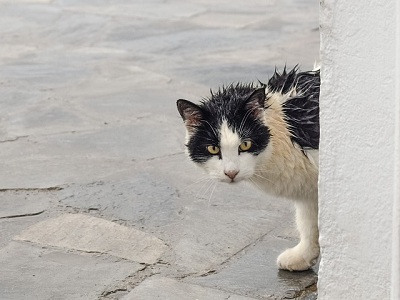How to Take Feral Cat to Vet?
How to Take Feral Cat to Vet?
Feral and semi-feral cats are difficult to handle. It is one thing to give them occasional food and water supply, and another to take them to a vet. Sometimes, they are injured, on other occasions, they are sick, or they can be injured. All of these situations require an immediate visit to a vet. But, a majority of cat owners finds it difficult to take a feral cat to a vet. They often wonder how to handle a cat without being scratched or injured. According to feline experts, the first step is to call a vet and ask them whether they do check-up with stray cats. Experienced veterinarians will make an examination easier for everyone. The next step is to get a cat into a carrier. The best strategy is to feed feral cat inside a carrier. Once the cat becomes accustomed to a carrier, they recommend closing the door and covering a carrier. To learn more about how to take a feral cat to a vet, the article “How Can I Get an Injured Feral Cat to the Vet?” gives us the following suggestion.
How to Take Feral Cat to Vet?
The way to trap a feral cat is with a humane trap, sometimes called a Havahart® trap. Your local animal shelter, your veterinarian, or animal control officer might have one you can borrow. If not, they can be purchased at home supply stores and other such outlets.
Once you get the trap, be sure to assemble and/or prepare it in a place where he won’t hear the noise and commotion. Be sure you know how to use the trap and that you’ve got it set properly. Line the bottom of the trap with newspaper to protect his paws, and then place it in a secluded location.
In your case, since you’ve been feeding your feral cat, we’d recommend that you put the trap where his usual feeding station is. Instead of putting out his usual food, bait the trap with about a tablespoon of a very tasty treat.
Alley Cat Allies recommends smelly foods such as tuna in oil, sardines, or baby food (without onions). You can also drizzle some of the juice from the food in a zigzag pattern along the floor of the trap toward the entrance
When the cat goes into the trap, he’ll (hopefully) step on the trigger plate, which will close the door of the trap behind him. However, some cats can be quite clever and get the food without tripping the trigger.
Be sure you keep track of the trap from a distance. Check it every 15 minutes to half hour. You don’t want the cat to be sitting in the trap for too long because of the stress level and the fact that he won’t be able to find shelter if it’s cold or rainy.
Once you’ve trapped him, put a cover over the trap (this will lower his stress and make him easier to handle, call your vet, and get him to the clinic as soon as you can. It’s normal for feral cats to thrash around inside the trap, and this sounds a lot worse than it actually is. Don’t open the trap or try to pet him.
One of the solutions to take a feral cat to a vet, according to experts, is to place a carrier with the door at its top. They advise us to take a cat, who otherwise rejects going inside, on a scruff with other hand on his lower back and place him inside. Usually, a cat curls up and that makes him easier to handle. To find a solution on how to take a feral cat to a vet, some people use a laser pointer. Interestingly, for many cats, it works.










